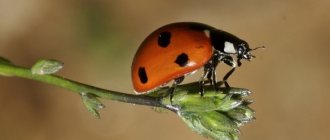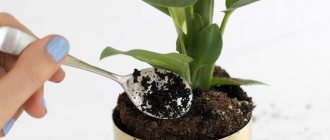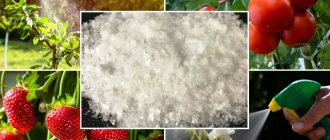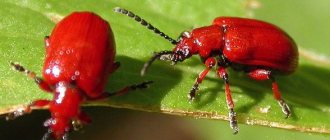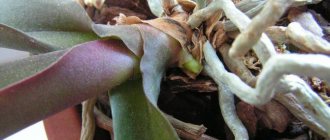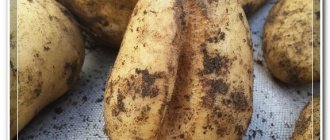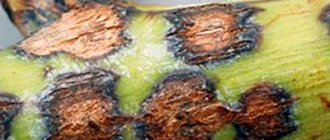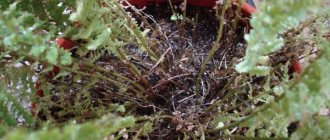Houseplants are no less susceptible to insect attacks than garden plants. Improper care of flowers contributes to the appearance of flying, jumping and crawling pests. Most of them are very dangerous for plants - they damage the root system, suck juice from leaves and stems, bite through buds, preventing flowers from blooming. A common occurrence is small white worms in the soil of indoor plants.
Types of insect pests similar to worms
White or transparent worms in indoor pots are a warning sign. Pests weaken the plant and slow down its growth. The flower stops producing buds, the leaves turn yellow and wither. These worms can be either adult insects or their larvae. Whatever they are, if timely measures are not taken, the plant may die.
Insect larvae
When we talk about larvae, we usually mean several genera of insects from the order Diptera.
Mushek
Springtails (springtails, springtails) are tiny arthropods no larger than 5 mm in size. They have a jumping fork in the lower part of their body, which allows them to move quickly. Some specimens are so small that they are difficult to see. Often, owners notice white worms in the tray, in the water remaining after watering. Insects live in the soil and feed on organic debris. If this nutrition is not enough for them, the roots of the flower and young shoots are destroyed. Waterlogged soil is a favorable habitat.
Fungus gnat
Representatives of the Sciarich family that indoor gardeners encounter:
- sciara midges;
- fungus gnats;
- genus Bradysia.
Only a specialist can find the differences between these insects, but the damage they cause and the methods of control are almost the same. The insect is a small mosquito. The length of the thin body is 3-4 mm, the head is round. It has only a front pair of transparent wings, and in place of the hind wings there are club-shaped halteres.
Insects fly well and reproduce quickly. A young mosquito has a light gray body, which turns black with age. Adults do not cause any particular harm to plants, but can carry various diseases and the larvae of other pests.
The main damage is caused by fungus gnat larvae - white, transparent worms 3-5 mm long with a black head.
Insects damage the root system of indoor flowers. The supply of nutrients and moisture to the plant is disrupted, and the flower may die. The larvae get in with the contaminated soil. The second way for adults to enter an apartment is from the street through open windows. Mosquitoes prefer waterlogged soil.
Nematodes
Nematodes (roundworms) are protostomes. Zoologists suggest the existence of about a million species on earth. They live in fresh and salt water bodies, in the soil.
Nematodes are tiny worms in indoor flowers that grow in moist soil and feed on living and dead plants.
Types of plant nematodes:
- Galls that settle on the roots, their secretions contribute to the formation of thickenings in which pests live and reproduce. When the eggs mature, the shell is destroyed and the larvae spread in the soil.
- Nematodes with free formation of cysts are attached to the root.
- Free nematodes do not have a permanent place of residence, crawling and damaging various plant organs.
Signs of nematode damage:
- the appearance of yellow and subsequently brown and black spots on the foliage;
- reduction in leaf size, their deformation;
- curvature of stems, drying of apical buds;
- the formation of thickenings and swellings on the root system.
Nematodes lay oval eggs, from which white, partially transparent larvae emerge.
Enhytrea
The appearance of enchytrea in house flowers is difficult to notice; they live on the roots of plants. If measures are not taken, the root system will be covered in worms. Signs of damage are stunted growth, yellowing of leaves. Enchitraea often appear in greenhouses; they love warmth and moisture. Pests look like small, mobile white worms with pointed ends. The body of the worm is translucent, through which the digestive organs are visible. These pests are good food for aquarium fish.
How to get rid of white small worms on the ground under flowers?
Perhaps there are fungus gnat larvae in the soil.
Most often you come across species with a completely white body with a small black “head”, as well as white-yellow varieties. The body of the larvae is segmented, like that of earthworms, so they are easy to distinguish from soil nematodes. Adults are “midges” that are annoying just by their presence. Fungus gnats can get into a flower pot with soil, but they actively multiply due to constant dampness in the pot, excessive humidity and stagnant air in the room. Most often, mosquitoes appear in the cool season, when there is little sun, the windowsills are cool, and in some periods (for example, during no heating) it is very humid.
The fungus gnat feeds on rotting organic matter, so its appearance can signal rotting of the root system. When larvae appear, it is recommended:
- reduce watering (do not water as often as in summer), allow the soil to dry out or dry to a certain depth depending on the type of plant (not all of them prefer constant dampness)
- increase lighting (artificially - lamps)
- stop spraying leaves during treatment
- replace the top layer of soil with a fresh one, adding the drug Muhoed, Bazudin or Grom-2 to it
- After each watering, carefully, without damaging the roots, loosen the soil so that it dries faster
- Do not add sleeping tea, “meat” water, fish remains, kefir, etc. to the soil, which causes fermentation and rotting processes in the soil.
Here the advice has already been given to pour a layer of sand on top. Yes, this method is very effective, like a layer of expanded clay, for example, but the fact is that neither one nor the other material will allow you to control the drying process of the soil itself or the time of watering, therefore, if you have little experience in floriculture, this option is better Do not use, otherwise the plant may rot.
Also, do not spill the soil with a solution of potassium permanganate, thereby contributing to even greater waterlogging in the pot.
For adults, use sticky fly tapes, insecticidal strips or mosquito repellent liquid in a fumigator.
For the future: before annual replanting, the soil should be thermally treated in a microwave oven or in a water bath.
Perhaps I was wrong with the definition of “worms”, then it is worth giving a more detailed description of them, since soil inhabitants are quite diverse and can belong to different species, interfere with the ecosystem in a flower pot, or be completely harmless.
Fighting methods
If there are pests in a flower pot, you need to get rid of them urgently. Depending on the degree of damage, choose control methods.
Mechanical
Since white worms live mainly in the soil, mechanical removal is ineffective. You can remove or wash off the adult specimens from the roots, but you will not be able to get rid of the eggs and larvae. If pests have just appeared, replant the indoor plant in healthy, calcined soil. Treat the soil with insecticides. When replanting, remove adult insects, larvae and eggs from the root system. Trim damaged areas and treat with disinfectant solutions.
Chemical
In a specialized store you will be offered several proven drugs for controlling soil pests:
- "Carbation" is a fumigatory agent. Used once to protect the flower and to sterilize the soil.
- “Agravertin” is a safe, highly effective product that does not cause addiction among pests, and its effectiveness increases in the hot season.
- “Fitoverm” – a few hours after treatment causes paralysis in pests, after 2-3 days they die. Apply by spraying, re-treatment is recommended.
- “Confidor” - the active substance penetrates the plant tissue, the effect lasts for a long time. The drug can only harm insects.
- "Intavir" is a nerve poison that affects most insect pests. Within half an hour the feeding process stops, and within 24 hours the pests die. Does not destroy eggs.
Chemicals are toxic; safety rules must be strictly followed.
Folk remedies
If you are not a supporter of chemical reagents, try folk remedies:
- Prepare a pale pink solution of potassium permanganate and water the indoor plant several times with this solution.
- Use a soap solution for spraying.
- Place citrus peels, garlic cloves near the flowers, and treat the soil with anise oil.
- Prepare a solution of 5 g of tobacco dust and a liter of water. After steeping for 24 hours, spray the plant and soil in the pot. Repeat the procedure once a week for 1-1.5 months.
Agrotechnical methods of getting rid of nematodes
Other preventive measures and means of combating nematodes without the use of chemicals are also conditionally effective. This:
- Maintaining crop rotation.
- Selection of varieties and hybrids that are relatively resistant to nematode damage (for example, for tomatoes - Nagano F1, Evpator F1, Malika F1; for garden strawberries - Festivalnaya, Zhemchuzhnitsa, Dessertnaya, Saxonka, Raketa; for potatoes - Scarlet, Fresco, Picasso, Diamant) .
- Careful selection of healthy seed.
- Warming the tuber bulbs and corms before planting for 15 minutes at a temperature of about 45-50°C or 3-5 minutes at a temperature of 55-60°C.
- Pre-plant disinfection of the soil with hot water, removal of the top layer, digging and mandatory mulching.
- Regular care of plantings - weeding and thinning.
- Careful watering - drops of water should not remain on the stems and leaves for a long time, because... this promotes the development of nematodes.
- Planting phytoncidal plants between rows that help repel pests, for example, marigolds or calendula.
- If an infection is detected during the growing season, promptly remove affected and weakened plants.
- After harvesting, remove all plant debris from the site and remove (burn) all remaining contaminated plant material along with the surrounding soil.
- To increase fertility and partially destroy the nematode, the area freed up after harvesting in August - early September is well sown with grain (preferably winter) crops. First, the area is cleared of weeds and plant residues, the soil is loosened and only then grains are sown “randomly” to a depth of 2-3 cm. When persistent frosts occur, the soil along with the winter crops is dug up, making a full rotation of the layer. In this way, it is enriched with organic matter and freed from the most dangerous pest - the nematode, which in such unfavorable conditions for it simply freezes out.
Prevention measures
It is easier to prevent insects from infecting plants than to fight them.
Listen to the advice of experts:
- Even if you notice one fly or worm, check all the pots.
- Replace the soil, wash the containers.
- Adjust watering, do not over-moisten the soil.
- Do not use folk remedies for fertilizer - tea leaves, meat juice. These products create favorable conditions for the proliferation of pests.
- Do not place vases with purchased flowers near indoor plants.
Monitor newly acquired plants and soil. Follow the rules of flower care; a healthy plant is less susceptible to pests.
If you find white worms in a flower pot, it's time to sound the alarm, because they are by no means harmless. Because of these pests, not a single new plant will be able to sprout in the ground, and an adult one may die.
enchytraea, or saprophytic species of nematodes , are probably developing in the soil
Enchitraea look like small white worms about 1-2 cm long. These are the closest relatives of earthworms. Aquarium fish lovers specially breed them for food. They live in the soil at a depth of about 10 cm.
They can be noticed if you remove the plant from the pot. They harm potted plants - they eat roots and tender shoots. The damaged plant begins to lag in growth, the leaves turn yellow and wither, and eventually the plant dies. High soil moisture and the presence of undecomposed pieces (organics) of plant residues contribute to the appearance of enchytraea. In places rich in food, enchitraea are found in whole balls.
Preventive actions
Do not allow the soil in the pots to become waterlogged. When moving plants outdoors, be sure to use trays to prevent insects from entering pots from open ground.
Control measures
- Keeping potted flowers drier.
- Immerse flowerpots completely in hot water to wash away insects.
- Replanting plants that have been affected by this scourge: rinse the pot and roots of the old soil and plant the plant in fresh soil. But such a procedure for a flower is not painless.
- The most effective way is to water the soil with an insecticide solution (Aktara, Bazudin, Inta-Vir, Fury, Fitoverm) or anti-helminth drugs (repeat twice with an interval of two weeks). In the spring, transplant the plants into new soil, carefully clearing the roots of the old soil.
- Land must be purchased from branded flower shops. First of all, check that the package is not torn and pay attention to the expiration date. Do not buy soil in counterfeit bags that do not have the manufacturer’s brand name and address.
Soil disinfection
The soil must meet all standards and be free of any pests, pathogen spores and weed seeds. But it’s still safer to disinfect the finished soil yourself.
You can pour boiling water or a hot (90°C) solution of potassium permanganate over the soil poured into a bucket and cover it on top to maintain the high temperature for a longer time.
But it’s better to steam the soil using any big old pan or bucket. Pour water (1/4 volume) into the bottom of the container. At a height of 1/3 from the bottom, install a lid with drilled holes (grid, colander bowl), which is covered with a large piece of cloth so that the soil does not spill out. Or pour the earth into a cloth bag. Cover the top tightly with a lid and boil for at least 40 minutes.
Disinfecting soil in the oven requires caution. The layer of earth should be no more than 8-10 cm, and the temperature should not be higher than 60-80°C. Heat treatment causes the death of not only pathogenic microorganisms, but also beneficial ones.
Sterile soil is very quickly (within 2-3 weeks) populated by new inhabitants, both harmful and beneficial. To ensure that there are as few of the former as possible, it is recommended to add vermicompost (1:10) to the disinfected cooled soil.
Garden
Houseplants are no less susceptible to insect attacks than garden plants. Improper care of flowers contributes to the appearance of flying, jumping and crawling pests. Most of them are very dangerous for plants - they damage the root system, suck juice from leaves and stems, bite through buds, preventing flowers from blooming. A common occurrence is small white worms in the soil of indoor plants.
Folk remedies for nematodes
The main and, perhaps, the only effective folk remedy for fighting nematodes is “cheap and cheerful” - pouring boiling water on the soil on the eve of planting. High temperatures are detrimental to tiny nematodes, and after this procedure their numbers in the area actually decrease noticeably. You just need to remember that for the real effect, the ground must be soaked with hot water with a temperature of at least 50-55 ° C to a depth of at least 15-20 cm. After this, it can also be covered with polyethylene so that it cools more slowly.
Alas, the measure is not fully effective. Although a significant number of nematodes live in the surface layers of the substrate and, as a rule, die during such thermal disinfection, some pests can migrate to deeper layers of soil and escape.
In addition to the soil, the affected plants themselves can be treated with hot water - this mainly concerns bulbs and roots damaged by root-knot nematodes. They are washed off the ground and then soaked in hot (45-50°C) water for 10-30 minutes. As a useful additive, formaldehyde can be added to this water at a concentration of 0.06%.
Types of insect pests similar to worms
White or transparent worms in indoor pots are a warning sign. Pests weaken the plant and slow down its growth. The flower stops producing buds, the leaves turn yellow and wither. These worms can be either adult insects or their larvae. Whatever they are, if timely measures are not taken, the plant may die.
Insect larvae
When we talk about larvae, we usually mean several genera of insects from the order Diptera.
Mushek
Springtails (springtails, springtails) are tiny arthropods no larger than 5 mm in size. They have a jumping fork in the lower part of their body, which allows them to move quickly. Some specimens are so small that they are difficult to see. Often, owners notice white worms in the tray, in the water remaining after watering. Insects live in the soil and feed on organic debris. If this nutrition is not enough for them, the roots of the flower and young shoots are destroyed. Waterlogged soil is a favorable habitat.
Fungus gnat
Representatives of the Sciarich family that indoor gardeners encounter:
- sciara midges;
- fungus gnats;
- genus Bradysia.
Only a specialist can find the differences between these insects, but the damage they cause and the methods of control are almost the same. The insect is a small mosquito. The length of the thin body is 3-4 mm, the head is round. It has only a front pair of transparent wings, and in place of the hind wings there are club-shaped halteres.
Measures to actively combat kiwis
At the moment, the list of pesticides and agrochemicals approved for use in the Russian Federation does not contain recommended preparations for protecting plants from grasshoppers. This is explained by the fact that the areas are treated with pesticides during daylight hours, when a significant part of the nooses are located in shelters and are not treated. Even the application of preparations aimed at destroying root pests of plants (wireworms, mole crickets) does not give a noticeable result in the fight against noose. You can use the drug Nemabakt - it works against soil-dwelling harmful insects, and even though nouns are not insects, there is a chance that nematodes will also be able to handle their larvae. You can find out more about Nemabact here >>>>>.
Fighting methods
If there are pests in a flower pot, you need to get rid of them urgently. Depending on the degree of damage, choose control methods.
Mechanical
Since white worms live mainly in the soil, mechanical removal is ineffective. You can remove or wash off the adult specimens from the roots, but you will not be able to get rid of the eggs and larvae. If pests have just appeared, replant the indoor plant in healthy, calcined soil. Treat the soil with insecticides. When replanting, remove adult insects, larvae and eggs from the root system. Trim damaged areas and treat with disinfectant solutions.
Chemical
In a specialized store you will be offered several proven drugs for controlling soil pests:
- "Carbation" is a fumigatory agent. Used once to protect the flower and to sterilize the soil.
- “Agravertin” is a safe, highly effective product that does not cause addiction among pests, and its effectiveness increases in the hot season.
- “Fitoverm” – a few hours after treatment causes paralysis in pests, after 2-3 days they die. Apply by spraying, re-treatment is recommended.
- “Confidor” - the active substance penetrates the plant tissue, the effect lasts for a long time. The drug can only harm insects.
- "Intavir" is a nerve poison that affects most insect pests. Within half an hour the feeding process stops, and within 24 hours the pests die. Does not destroy eggs.
Chemicals are toxic; safety rules must be strictly followed.
Folk remedies
If you are not a supporter of chemical reagents, try folk remedies:
- Prepare a pale pink solution of potassium permanganate and water the indoor plant several times with this solution.
- Use a soap solution for spraying.
- Place citrus peels, garlic cloves near the flowers, and treat the soil with anise oil.
- Prepare a solution of 5 g of tobacco dust and a liter of water. After steeping for 24 hours, spray the plant and soil in the pot. Repeat the procedure once a week for 1-1.5 months.
Many gardeners are convinced that matches stuck with sulfur heads into the soil help deal with white worms in the soil.
Nodding at home – to be afraid or not
Kivsyaki are vegetarians, so they prefer to live in nature, among vegetation. They settle under stones, in piles of tops, under the remains of building materials. In these places, moisture is retained longer, and centipedes are also protected from sunlight. There are times when nooks break into the house. This occurs during periods of high humidity when the number of invertebrates becomes enormous. They are looking for new territories to settle. Choose rooms in the house where there is water - kitchen, bathroom. They can scare impressionable owners by crawling along walls and ceilings.
Diplopods are active at night; the sun dries out their bodies. They do not bite and are not carriers of diseases and infections. When threatened, centipedes curl into a tight spiral. This is how they protect the abdomen. Odorous and poisonous secretions from holes on the side help scare off predators. They are absolutely harmless to people; just wash your hands with soap.
Neighborhood with centipedes does not make anyone happy. When they appear, the question becomes acute: how to get rid of clowns in the house? Unfortunately, the action of insecticides on them is not always effective. It is better to use baited traps. They are laid out in the evening; to attract centipedes, cut potatoes and wet rags are taken. In the morning, the nods are trapped, they are collected and destroyed. You can add Pochin along with the food bait. This is an insecticide in the form of granules recommended for the destruction of soil pests.
Prevention measures
It is easier to prevent insects from infecting plants than to fight them.
Listen to the advice of experts:
- Even if you notice one fly or worm, check all the pots.
- Replace the soil, wash the containers.
- Adjust watering, do not over-moisten the soil.
- Do not use folk remedies for fertilizer - tea leaves, meat juice. These products create favorable conditions for the proliferation of pests.
- Do not place vases with purchased flowers near indoor plants.
Monitor newly acquired plants and soil. Follow the rules of flower care; a healthy plant is less susceptible to pests.
Found a mistake? Report it: 1) Select the error with the mouse 2) Press CTRL+Enter. Read more.
Comrades, help. Transparent, white worms (1-2cm) appeared in the cups with the babies. I thought about the nematode. But they write that it can only be seen through a microscope. And mine are already clearly visible. Who is this? Are they dangerous? The children are growing well and there seem to be no signs of nematodes.
- Login or register to post comments
- 29792 views
- print version
How to identify a pest
In cold, wet spring, when plants are growing slowly, millipedes chew cavities in their root systems. These areas darken, and if there is a large area of damage, the crop dries out. Damage to strawberries is indicative. Kivsyaki make depressions of various sizes in the soft berries. In some cases, larvae remain inside. Typically, centipedes prefer rotten vegetables and fruits, but they will also crawl onto fresh ones. Especially if they are located close to the ground. The following crops are at risk:
- sugar beet;
- zucchini;
- potato;
- carrot;
- melon;
- tomatoes.
Not only the spotted nodule, but also other species - gray, Crimean, sandy - may appear on the site. All of them have a segmented body with double pairs of limbs, different colors - from steel to black. Millipedes breed in open and closed ground. In the humid environment of a greenhouse, they reproduce at a high rate.
Attention. It is important to start destroying the pest in time; in a day they eat an amount of food that exceeds half their own weight.
Comments
Sorry, I’ll ask again, are you right - 1-2 centimeters long? So big?
- Login or register to post comments
there was probably something in the ground.
can be watered with Bazudin.
if you don’t find it, then with Agravertin, Aktara, Aktellik
- Login or register to post comments
These are the larvae of fungus gnats (sciarids). I just brought them into the apartment with the baby I bought. I also saw one white worm with a black head in a transparent glass and at first did not attach any importance to it, but later I was tired of fighting with them. Actellik helped, diluted 2 ml per 1 liter of water and spilled all the flower pots.
- Login or register to post comments
I completely agree with the girls! They are not dangerous, but it would be better to get rid of them.
- Login or register to post comments
A fumigator with liquid or tablets against mosquitoes helps very well against sciarids; the flying ones gradually die out, however, you need to turn them on for at least a week, since those in the ground also gradually ripen.
Worms are nematode pests
A serious danger in the countryside is posed by nematodes - tiny worms that are pests of the garden. By infecting plants, they lead to the occurrence of nematode diseases. Plants infected with nematodes lag behind healthy ones in growth, and their leaves curl in warm weather. The root system produces few thin lateral branches, the plant darkens and looks depressed. Hardly visible harmful worms in the soil in the garden (photos and names are indicated) infect many plants.
Small pest worms in the garden gnaw the bases of stems, roots and leaves. It's difficult to fight them. Gray worms are resistant to biological products. To fight them, bait is prepared.
- Bran - 1 kg.
- Melissa - 0.1 g.
- Votexit - 50 g.
What are these white worms in an indoor flower?
- Fly larvae;
- Nematodes;
- Enhythrea;
- Fungus gnat larvae (sciarids);
Parasites settle on a houseplant if the plant is weakened or the indoor microclimate is conducive to reproduction. They are usually localized on the lower leaves, in the upper soil layer of the pot, and on the roots of the flower. Both adult plants and larvae feed on the juices of the indoor flower, and the latter begins to get sick, withers and dies.
Fly larvae, sciarids up to 4 mm in length, white. Adult hatchlings have wings. They reproduce equally in moist and dry soil - they are more attracted to the environment in the room where they are comfortable.
Enchytraea are white worms up to 2 mm. They are similar to earthworms, as they are the closest relatives to them. If you are not a fan of fish in the aquarium that are fed with enchytraea, remove the parasites, otherwise they will multiply, each time capturing a deeper layer of the soil mixture. They appear in waterlogged soil and love rotted organic matter.
How to remove white worms from an indoor flower?
Since most of the midges and worms are in indoor flowers, we will dry the soil mixture to kill the pests.
How to remove white worms from an indoor flower:
- Stop watering the plant;
- Fill in expanded clay, dry hydrogel, beads - it prevents stagnation of water and prevents the laying of larvae;
- To catch and poison midges - spread sticky tape over the pot and spray the midges with dichlorvos (attention: ventilate the room before sleeping);
- Mix wood ash + tobacco shavings into the soil;
- Clean the sulfur from the match head;
The listed methods will help kill white worms in indoor flowers, but if there are too many of them, you will have to use chemicals.
How to treat flowers against white worms:
After several stages of treatment and elimination of white worms, replant the houseplant into a healthy, fresh soil mixture. Treat the substrate and prevent the reappearance of parasites. During the replanting process, you may notice larvae or worms on the root system - remove them, trim off the damaged areas and treat the roots.
Soil treatment against white worms in flowers
The soil mixture is steamed or spilled with a solution of potassium permanganate before use. Try not to over-moisten the soil in the pot, lower the humidity and air temperature to a level comfortable for indoor flowers. Carry out insecticide prevention once a year.
↓ Write in the comments how you managed to cope with the invasion of white worms in indoor flowers? What methods did you use? Were you able to completely get rid of the parasites?
Please rate the material you read :)
little white worms
Status: Offline
little white worms
Message from Myshulka » 04/12/2010, 10:29
Status: Offline
Message from Andrey Vasiliev » 04/12/2010, 10:35
Status: Offline
Message from Myshulka » 04/12/2010, 11:14
Messages: 95 Registered: 03/12/2010, 19:04 From: Dzerzhinsky - MKAD - South-East
Status: Offline
Posted by Sigma » 04/12/2010, 2:26 pm
Status: Offline
Message from Stepanida Petrova » 05/07/2010, 10:11
I bought edible passionflower seeds. Planted it. They didn't sprout for a long time. I dug it up - a similar story. Indeed, there are a lot of tiny white thin sharp worms inside the shells and the seeds themselves are eaten away. And this is not a mealybug!
Mouse, have you already found out what these worms are? Please share information
Messages: 3797 Registered: 06/27/2008, 10:30 AM Interests: son, husband, dacha, heartbreaking detective stories (like “bloody big toe”) Occupation: a little of everything From: Moscow, River Station. Dacha-Elektrogorsk. d/d December 16. Thanked: 7 times
Status: Offline
Message from Ksyukha » 05/07/2010, 10:45
Status: Offline
Message from Stepanida Petrova » 05/07/2010, 11:27
Eureka! I think I've found the answer!
Here: There are some kind of “worms” in the pots; they stick to all the seeds. What kind of worms are these? how to deal with them?
Most likely, these are the larvae of the greenhouse fly (thin, transparent white ones, 1-3mm). This happens when the seeds begin to rot. Apparently the seeds suck (since the worms are sitting on the seeds, it means they are already feeding on the rotten part of the seeds). Apparently, the ground was very waterlogged when the seeds were planted - they suffocated and began to rot. Most likely, there is nothing left to save—throw away such seeds and try again. And for the future - do not over-moisten the soil, ventilate (if the container with the seeds is covered with a lid), disinfect the soil before planting the seeds (in general it is better to use a mixture of peat with sand or perlite - such a mixture usually does not contain any evil spirits), and do not bury the seeds deeper than them own size. You can kill current larvae with any insecticide containing pyrethroids, for example by spraying the top layer of soil or watering the soil. Or any means for killing pests on lawns (sold in garden stores). If you don’t have anything at hand, try pouring a weak solution of potassium permanganate. Better yet, throw this soil away.
Messages: 372 Registered: 10.27.2009, 15:34 From: Orenburg region Thanked: 4 times Thanked: 36 times
Status: Offline
Posted by iehjxrf130 » 05/07/2010, 17:16
What to do if there are white worms in an indoor flower? :
One day, not yet knowing what to do with them - there were small white, motionless, apparently larvae and nimble little adults - I pulled the flower out of the ground, transplanted it into another, and simply took this one with the worms outside into the cold and specially checked it later. There was no one there anymore, and I used this soil later or not, I don’t remember. Now it’s the same story with another flower, but I just replanted it, so what, should I replant it again?
Three times in the winter I replanted the balsam (wet vanya) and washed it in manganese and still it appeared again, although the ground was frozen.
They say that soaking doesn’t help, you just need heat treatment, steam or something else.
I baked all the soil in the oven, and it didn’t do anything. Mom suggested a recipe for iodine + milk + water, maybe it will help.
Worms in the garden - we breed them ourselves.
In order to saturate your garden plot with free soil disintegrants, you should start with the simplest thing - prepare a wooden box or dig a small square hole in the garden
- Fill it with leaves, soil, waste paper and pour a small layer of slop on top of everything.
- The whole thing should stand for a week so that the contents are thoroughly soaked.
- Then place several earthworms on the surface: 2-3 will be enough to get “large offspring” in the future.
- Water with settled or rain water from a watering can - tap water can kill small individuals.
Now you know how to breed worms in the garden, but there are a few more points that may be useful in this process:
- It is advisable to loosen it about twice a week to saturate all layers with oxygen.
- Monitor the health of your “pets”: if they are active and clean, have a pinkish tint, then everything is going as it should.
- Otherwise, bait is required in the form of: tea leaves, potato peels, even bread crumbs will do. It is usually administered weekly, in small portions (in layers of a couple of centimeters).
To remove all the worms without using your hands, this may seem like a nasty process to some, let them starve for several days, then put some food somewhere - they will all get out of the processed vermicompost on their own.
Earthworms
Earthworms are the main soil formers that contribute to soil aeration and moisture.
They feed on plant remains, but pose some danger to immature garden and flower crops. Actively moving in the ground, worms can damage thin roots and cause plants to dry out. Indoor flowers can suffer the most from worms.
It is almost impossible to fight these insects in open ground. But it’s quite easy to protect indoor flowers from their effects. To do this, place the pot in a bowl of water for eight minutes. The worms begin to choke and crawl out on their own.
How often gardeners are in for an unpleasant surprise! We had just planted seedlings of tomatoes and cabbage, the seedlings had already begun to grow, cucumbers began to grow, and suddenly, here and there the plants withered and fell as if they had been cut down. What is the reason?
